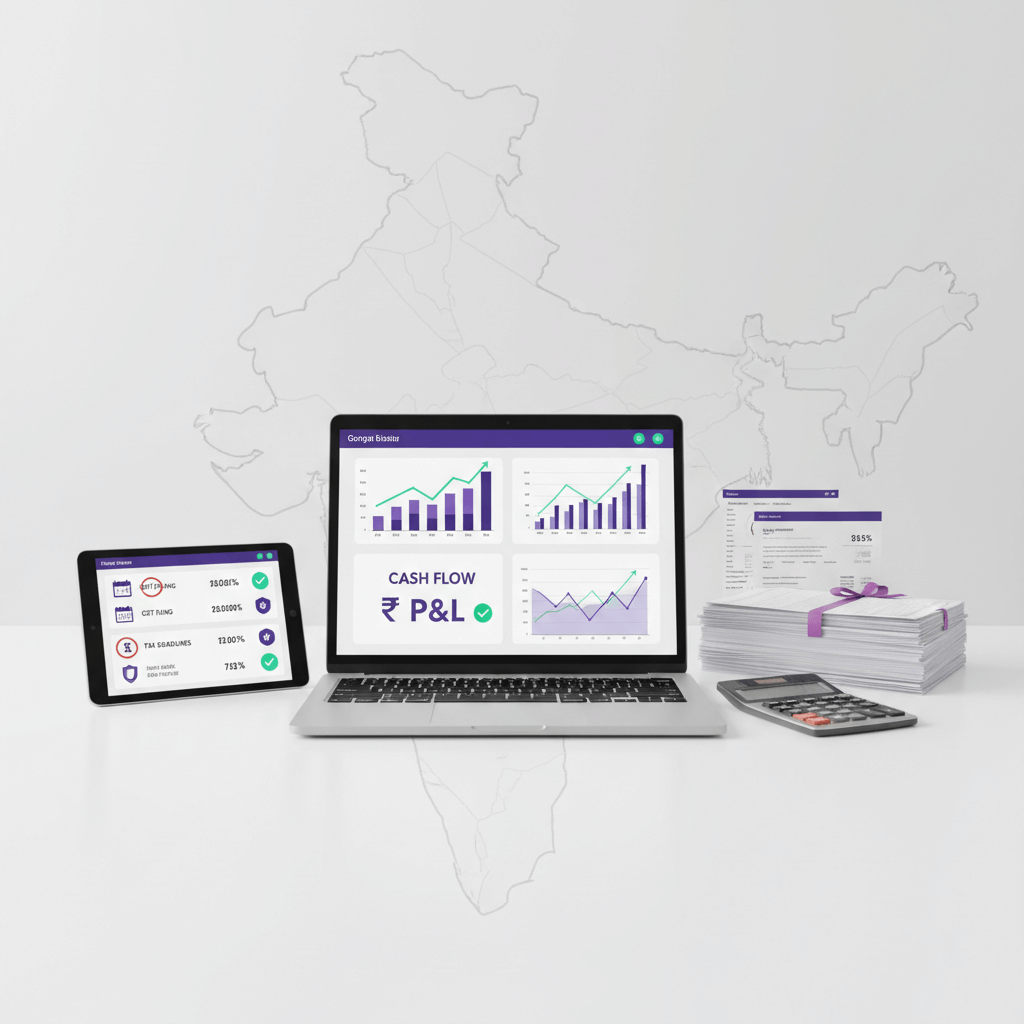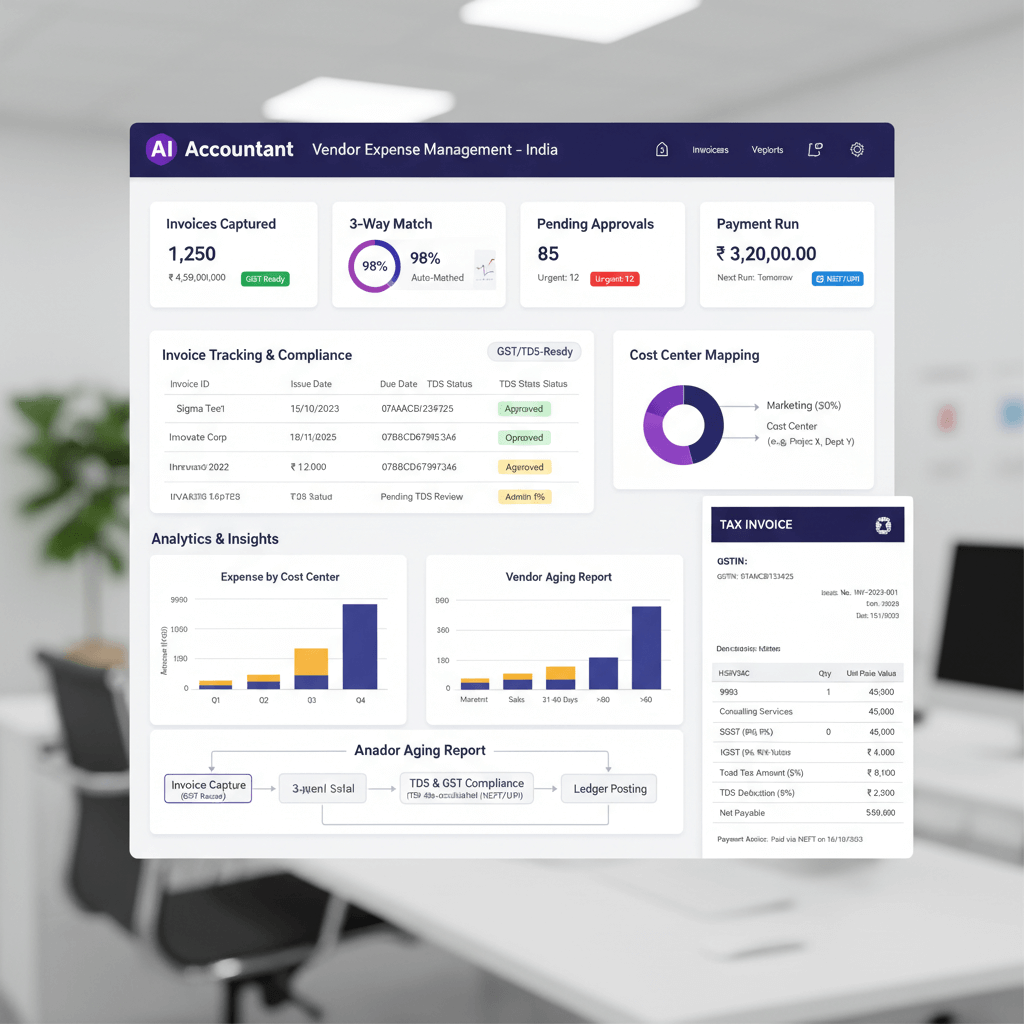Key Takeaways
- Cost efficiency: Outsourcing to India can cut overhead by up to 65% compared to in-house bookkeeping.
- Access to expertise: India’s large pool of English-speaking accounting professionals covers both Indian and international standards.
- Scalability: Scale your team up or down seamlessly during peak filing seasons without hiring hassles.
- Strategic focus: Offload routine tasks to focus on high-value advisory services and client relationships.
- Hybrid power: Combine outsourcing with AI automation tools like AI Accountant for maximum efficiency.
Table of Contents
- Key Takeaways
- What Is Outsourced Bookkeeping in India?
- Why CA Firms and Businesses Turn to Outsourcing
- The Clear Benefits of Outsourcing Bookkeeping
- Different Models of Outsourcing Accounting Work
- How AI Automation Enhances Outsourcing Success
- Critical Factors to Consider Before Outsourcing
- Comparing Your Options: Outsourcing vs Automation vs Hybrid
- How AI Accountant Supports Firms Using Outsourced Bookkeeping
- Making the Right Decision for Your Firm
- FAQ
What Is Outsourced Bookkeeping in India?
Outsourced bookkeeping means handing over routine accounting tasks to external specialists who handle everything from data entry to compliance reporting. Instead of hiring a full in-house team, you partner with offshore accounting teams, virtual accountant services, or staff augmentation providers. Outsource bookkeeping India has become the go-to solution for many CA firms and growing businesses.
Why CA Firms and Businesses Turn to Outsourcing
“It’s March, GST filing season is in full swing, and your team is working until midnight trying to reconcile months of transactions.”
During peak filing seasons, bank reconciliation, invoice matching, and regulatory compliance can overwhelm even well-staffed teams. Talent shortages make hiring qualified bookkeepers costly and time-consuming. Seasonal spikes demand unpredictable resources – double the workforce one month, idle staff the next. Meanwhile, clients expect real-time dashboards, cash flow forecasts, and actionable insights that strain traditional setups.
Outsourcing offers a relief valve for these pain points, delivering skilled teams on demand and stable service levels regardless of seasonality.
The Clear Benefits of Outsourcing Bookkeeping
- Cost savings: Reduce fixed costs of salaries, benefits, training, and office space by paying only for services used.
- Expertise on demand: Tap into India’s large pool of accounting professionals versed in diverse industries and compliance regimes.
- Effortless scalability: Scale your team up or down without layoffs or long recruitment cycles.
- Focus on advisory: Reclaim time for high-value activities like compliance strategy, financial analysis, and client advisory.
Different Models of Outsourcing Accounting Work
Offshore Accounting Teams
Comprehensive remote teams manage accounts payable, receivable, bank reconciliation, financial reporting, and compliance. Advantages: deep expertise, end-to-end coverage, easy scalability. Challenge: less day-to-day control and the need for strict communication protocols.
Virtual Accountant Services
Freelancers or small firms handle specific tasks such as ledger maintenance, GST compliance, or payroll processing. Benefits: quick setup, flexibility, cost effectiveness. Downsides: variability in standardization and possible service gaps during peak periods.
Staff Augmentation for CA Firms
Integrate junior accountants or bookkeeping specialists into your existing team structure. You maintain control while filling skill gaps. Considerations: integration challenges and training requirements.
How AI Automation Enhances Outsourcing Success
Combining outsourcing with AI tools creates a hybrid solution that boosts efficiency. AI Accountant can process bank statements, predict ledger accounts and GST codes, and sync with Tally or Zoho Books, reducing manual work by up to 75%.
When your outsourcing team receives pre-processed data, they focus on quality control, exception handling, and strategic analysis rather than data entry.
Critical Factors to Consider Before Outsourcing
- Data security and confidentiality: Ensure secure file transfers, encrypted storage, and compliance with data protection regulations.
- Integration capabilities: Verify compatibility with Tally, Zoho Books, QuickBooks, or your chosen software stack.
- Quality control and accountability: Define SLAs, turnaround times, accuracy standards, and escalation procedures.
- Standardized chart of accounts: Establish consistent coding standards for smooth handovers and consolidation.
- Training and handover planning: Document processes, allocate onboarding time, and set communication protocols.
Comparing Your Options: Outsourcing vs Automation vs Hybrid
Pure outsourcing delivers cost efficiency for large volumes and seasonal spikes but requires trust in your partner’s quality systems. Automation-focused strategies excel for repetitive tasks and offer low ongoing costs but struggle with exceptions. Hybrid approaches combine the best of both worlds, automating routine work and leveraging human expertise for complex scenarios.
How AI Accountant Supports Firms Using Outsourced Bookkeeping
AI Accountant integrates seamlessly into offshore and virtual accounting workflows. It handles OCR for major Indian banks, automates GST compliance, and syncs with Tally and Zoho Books. By delivering clean, categorized data, it reduces coordination overhead and accelerates onboarding for staff-augmentation roles.
Making the Right Decision for Your Firm
Outsourcing bookkeeping in India offers cost savings, expert access, scalability, and faster turnaround times. The key lies in selecting the right model and implementing controls for quality. A hybrid approach with AI automation tools like AI Accountant allows you to start small, measure results, and scale confidently. By outsourcing routine tasks, you free capacity for higher-value advisory services, enhancing client satisfaction and driving growth.
FAQ
How do I evaluate data security when choosing an outsourcing partner?
Ask potential vendors about their encryption methods, secure file transfer protocols, and data handling procedures. Request their security certifications and inquire how they enforce access controls. For example, AI Accountant uses end-to-end encryption and role-based access to protect financial data.
What is the ideal transaction volume for pure outsourcing?
Pure outsourcing suits firms managing high transaction volumes or facing significant seasonal peaks. If you process hundreds of invoices monthly or require extensive reconciliation, offshore teams deliver the scale and cost efficiency you need.
Can a small CA practice benefit from virtual accountant services?
Yes, virtual accountant services offer flexibility and quick setup for practices with modest bookkeeping needs. You can engage services for specific tasks like GST filings and ledger maintenance without long-term commitments.
How does AI Accountant integrate with Tally and Zoho Books?
AI Accountant exports categorized transaction data in Tally and Zoho Books formats. It automatically maps ledger accounts and GST codes, generating import files that reduce manual entry and error rates.
What are the key SLAs to define in an outsourcing agreement?
Define turnaround times for monthly reconciliations, invoice processing, and compliance report delivery. Specify accuracy thresholds, error resolution timelines, and escalation paths for urgent issues.
How do I maintain process consistency across offshore teams?
Establish a standardized chart of accounts and detailed process documentation. Conduct regular training sessions and use collaboration tools to share updates and address exceptions in real time.
Is staff augmentation better for temporary peak periods?
Staff augmentation allows you to supplement your in-house team during busy seasons. You retain control over workflows while scaling capacity, then scale back when demand subsides, avoiding layoffs.
What cost savings can I expect from a hybrid outsourcing-automation approach?
Combining outsourcing with AI automation can yield overall cost reductions of 60–75%. Automation handles repetitive tasks, while offshore teams tackle exceptions, optimizing resource allocation.
How long does it take to onboard an outsourced bookkeeping team?
Onboarding typically takes 2–4 weeks, including process documentation, software integration, and initial training. Using AI Accountant can shorten this period by pre-classifying transactions and providing clean data.
How do I measure the success of my outsourcing initiative?
Track metrics like turnaround time, error rates, cost per transaction, and client satisfaction. Compare pre- and post-outsourcing performance to quantify savings and identify areas for improvement.

-01%201.svg)


